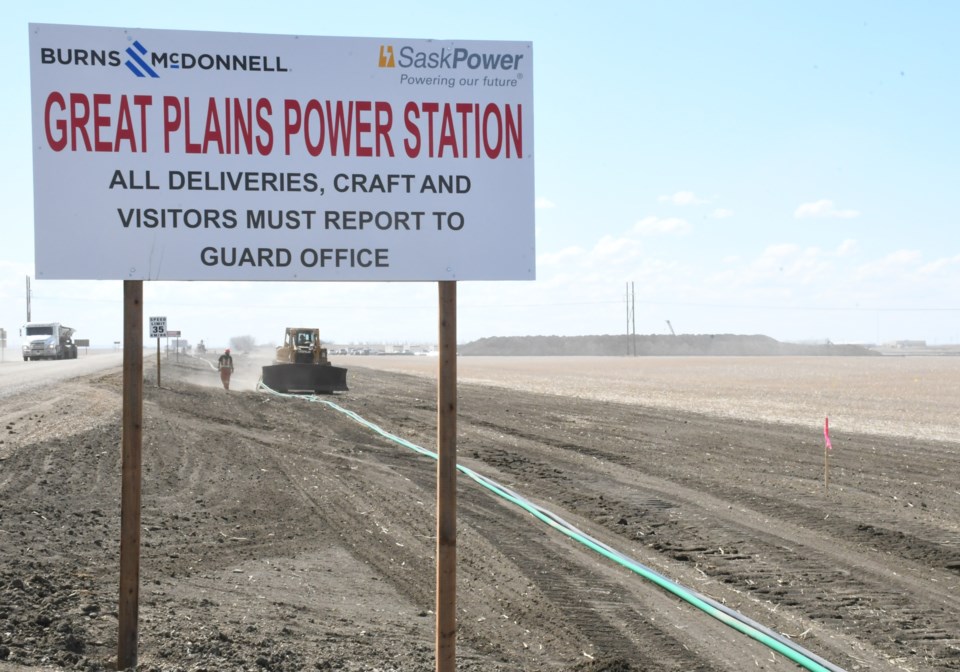The construction of SaskPower’s Great Plains Power Plant in Moose Jaw is expected to contribute to the continued growth of Saskatchewan’s construction industry in 2022 and 2023, experts say.
After reaching a floor in 2020, Saskatchewan’s construction market enjoyed growth in 2021 and appears poised to see another sustained expansion period, said analyst BuildForce Canada.
Labour market projections for the construction and maintenance sector suggest that a recovery in new-housing construction will combine with a provincial capital investment plan to drive construction employment higher in the near term. This will be followed by new mining opportunities driving longer-term growth opportunities.
BuildForce Canada’s 2022–2027 Construction and Maintenance Looking Forward report for Saskatchewan focuses on a six-year horizon for labour market data instead of the 10 years studied in previous reports.
The shortened forecast period allows the report to clearly identify short- and long-term demand and supply pressures affecting the province’s construction sector.
“Saskatchewan’s construction market is expected to remain on an upward trend through 2023, driven by residential activity, major public expenditures, and the anticipated start of a potash mine expansion, a canola processing plant, and a natural gas power plant in Moose Jaw,” said Bill Ferreira, executive director of BuildForce Canada.
“We anticipate that investment will cycle down slightly in 2024 before ramping back up again through the end of our forecast period.”
Such growth may present recruiting challenges, however. BuildForce anticipates that nearly 5,000 workers, or 13 per cent of Saskatchewan’s 2021 construction labour force, will exit the workforce through retirement in the next six years. Demand during this period will require an extra 1,100 workers, bringing the total recruitment requirement to 6,100 workers between 2022 and 2027.
Given Saskatchewan’s younger demographics, most of the industry’s hiring requirements could be met by an estimated 5,260 first-time new entrants under the age of 30 from the local population, said BuildForce Canada.
This would leave a gap of about 860 workers who will need to be recruited from elsewhere. In the non-residential sector, new entrants are expected to exceed the number of exits to retirement.
Developing skilled tradespersons in the construction industry takes years and often requires participation in a provincial apprenticeship program. Registrations in Saskatchewan’s 16 largest construction trades programs have declined over the past decade, falling by 54 per cent from 2012 to 2019.
The latest Registered Apprentice Information Systems data suggests new registrations slowed in 2020, resulting in a further 22-per-cent decline from 2019 levels.
At the current pace of new apprenticeship registrations and completions, several trades could be at risk of undersupplying the number of new journeymen required by 2027, BuildForce Canada said. These trades include boom truck operator, carpenter, insulator (heat and frost), refrigeration and air conditioning mechanic, scaffolder, sheet metal worker, steamfitter/pipefitter, and welder.
The construction industry remains focused on building a more diverse and inclusive labour force. To that end, efforts are ongoing to enhance the recruitment of people from groups traditionally underrepresented in the province’s construction labour force, such as women, Aboriginal People, and immigrants.
In 2021, there were about 5,720 women employed in Saskatchewan’s construction industry, a figure that is almost unchanged from 2020. Of them, however, only 39 per cent worked directly in on-site construction. As a share of the total, women made up just six per cent of the 35,300 tradespeople employed in the industry in 2021.
That figure is also unchanged from 2020.
The Aboriginal population is another underrepresented group that presents recruitment opportunities for the construction industry. In 2021, about 63,700 First Nations people were employed in Canada’s construction sector, or nine per cent of all indigenous people in the workforce.
As the Aboriginal population is the fastest growing in Canada and such workers seem predisposed to pursuing careers within the sector, there may be scope to further increase the recruitment of Indigenous people into the province’s construction industry, said BuildForce Canada.
The construction industry is also committed to recruiting newcomers to Canada. Saskatchewan is expected to welcome an average of more than 5,800 immigrants every year through 2027, making the immigrant population a key potential source of labour force growth.
For more information, visit www.buildforce.ca.




